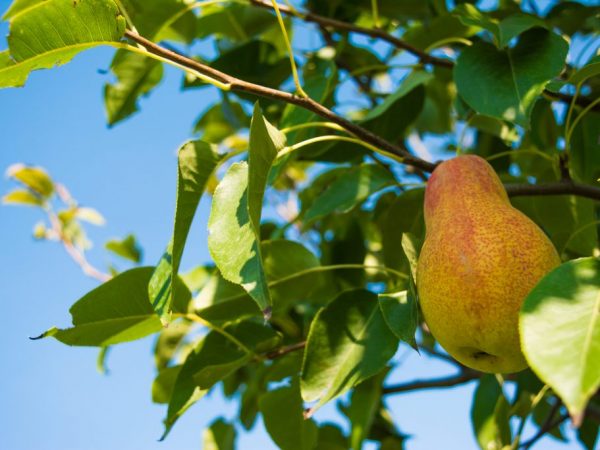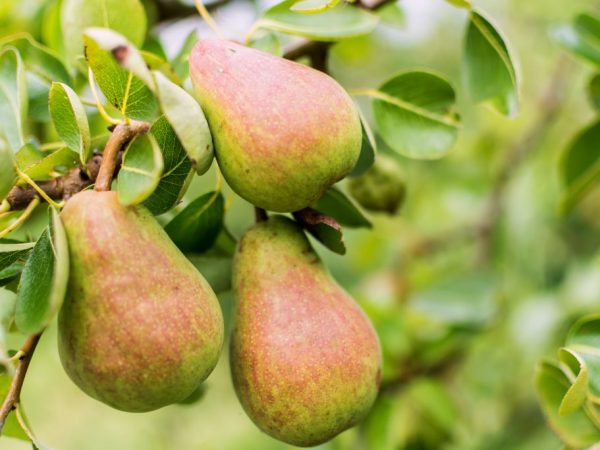Description of Allegro pear
The Allegro pear is a summer variety. It was bred about fifteen years ago from the Osennyaya Yakovleva variety. From him, the variety received a sweet fruit taste and resistance to scab. Since then, none of the gardeners who dealt with him have had any particular complaints about the size of the harvest or the conditions for keeping the pear.

Description of Allegro pear
Characteristics of the variety
The description suggests that the culture grows medium in size - in the region of 3 m in height. The main fruiting period is August. The fruits ripen unevenly, which allows you to enjoy fresh fruits for a whole month. The yield is consistently high. Fruiting begins in the fifth year after planting.
The variety is not capable of self-fertilization, so before planting, you should make sure that there are pollinators nearby. These can be summer varieties of pears Avgustovskaya Kosa and Chizhikovskaya. Apple trees with early flowering and fruiting are excellent pollinators.
Description of the tree
Shoots are light brown, wavy in shape. The stalk is small. Leaves are oval with a pointed end and dusty edges. The color of the leaves is not the same from different sides - from the outside it is shiny dark green, from the inside the color is matte and lighter.
The pear grows quickly enough, although it does not begin to bear fruit soon. The crown is not thick and not too bulky. The branches are slightly bent to the ground and have a slightly curved shape.
Description of the fetus
The average weight of one fruit is 130-140 gr. The shape is oval, pointed towards the top. The skin is very thin and shiny, pale green with a slight pink tint. When ripe, green slowly transforms into yellow, and pink - into small burgundy "cheeks". The pulp is white, soft and very juicy. Like the donor variety, Allegro tastes very pleasant, sweet without any signs of astringency. Also, pears have a strong and pleasant aroma that no one else has.
The taste and presentation of the fruits remain for two weeks, but they need to be stored in the refrigerator or at least covered with something on top, otherwise you risk getting a flock of very persistent "fans" - wasps and moths. The culture is universal, it is perfect for consumption immediately after being plucked from a pear and for making jams, preserves, etc. In addition, during the ripening of the fruits, you need to be very careful - these fruits tend to overripe quickly, at the same time becoming too soft and not very tasty, so you need to harvest the crop at the moment when it is not yet ripe, this will slightly increase its shelf life ...
Benefits
The description says that the most significant benefits of culture are:
- high winter hardiness (the tree is able to survive winter at -380C);
- high productivity;
- excellent fruit taste;
- resistance to scab and similar diseases (that is, to fungal).
Landing
Like most other pear varieties, Allegro does not like two things - the wind and the lack of sun.A place for landing should be chosen well-lit, protected from the wind. If the groundwater is closer than 2 m from the surface, then a small mound should be erected at the landing site.
If you want to plant your seedling in the spring, then the preparatory robots should be carried out in the fall. Conversely, if planting will be carried out in the fall, then preparation for planting should begin in the spring.
A hole is dug with a diameter of 1 meter and a depth of half a meter. It should be filled with a nutrient mixture. It consists of 1.5 buckets of black soil and 10 kilograms of manure. Fertilizers are also added there - ash and superphosphate, for example.
Immediately after planting, the seedling is recommended to be secured with a rope and several pegs. Then the ground around the trunk should be well tamped, the trunk circle should be filled with water and mulched with sawdust, peat or ash. Moisture should remain in the ground for a long time, but it is also not worth it to overfill the trunk circle.
Care

The quantity of the crop depends on the quality of care.
Taking proper care of a tree can significantly extend its life and increase its yield. The main recommendations for care will be as follows:
- annual and biennial seedlings should be shortened in length (for annuals it is about 1 meter of growth);
- in young trees, the ovaries should be partially cut off - otherwise, this will greatly affect the growth and quality of the fruits;
- the seedlings should also shorten the growth, this will increase the yield of the tree by a third in the future.
Watering
In addition, the tree needs watering. If the summer is not too dry and hot, then 4-5 waterings per season will be enough. Otherwise, the plant will need more water, depending on temperature and rainfall. Watering is best done by sprinkling to simulate natural rainfall, but you can pour water directly under the trunk. With the latter method of irrigation, it must be remembered that Allegro does not like it when there is water at the trunk for a long time - its excess should be drained away with the help of drainage channels. After the water disappears, loosening or mulching must be carried out.
Whitewash
Another danger is sudden temperature changes. Both young shoots and already formed ovaries can suffer from such changes. Experienced gardeners advise the next way to deal with this - in the spring and autumn, whitewash with a mixture of water-based paint and Bordeaux liquid.
Diseases and pests
In general, the culture has good immunity against most diseases - in particular against fungal. Some prevention is still worth carrying out - this is cleaning weeds, timely harvesting of fallen leaves and crumbling fruits. This will help to avoid those few diseases to which this culture is still susceptible.
Cracks are not a disease, but are the result of temperature or mechanical stress. However, cracks with a high degree of probability can cause a disease, therefore, immediately upon detection, they should be cleaned with a metal brush, rinsed with a 1% solution of Bordeaux liquid and sealed with either clay or a special putty.
Bacterial burn
Dark brown or black spots are a sign of a fire blight. It is treated by removing the affected areas, processing the cut with 1% copper sulfate or 0.7% iron sulfate. You can use the drug Azophos in a 5% dosage. Processing is carried out in May-June. If the damage is already significant, then trees within a radius of 5 meters should be uprooted and burned.
Mosaic disease
Sharp pale green or light yellow spots on young leaves are a clear sign of this ailment. There is no cure for it. Trees affected by it should be destroyed immediately, otherwise you risk losing the entire garden.
Root cancer
Expressed in the form of disproportionate growths on the roots of young seedlings. The affected areas should be excised and disinfected with 1% copper sulfate.
Conclusion
As a result, we can say that Allegro is a good variety with excellent taste. With proper care and timely prevention of diseases, the tree will live a long time and delight its owner with a stable, high-quality harvest. This pear will be a great addition to the garden of any sweet tooth.


